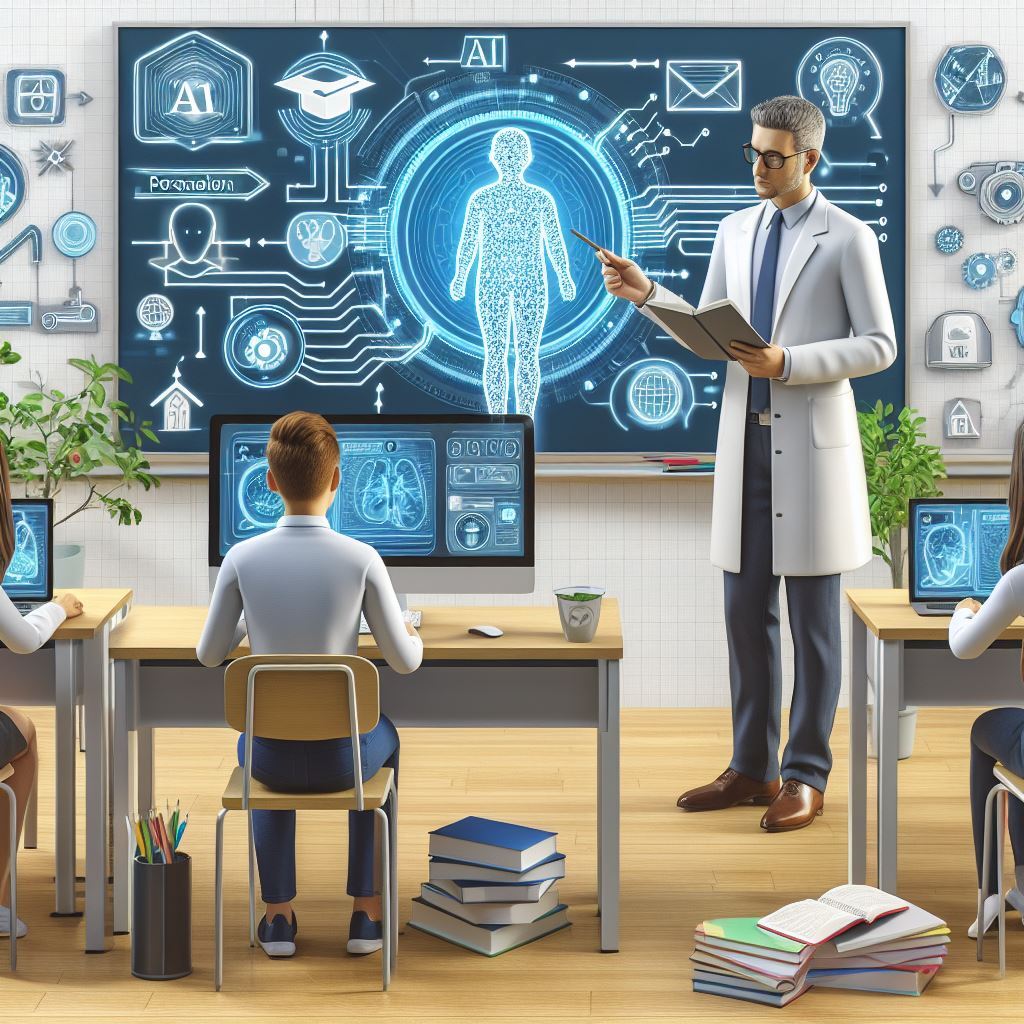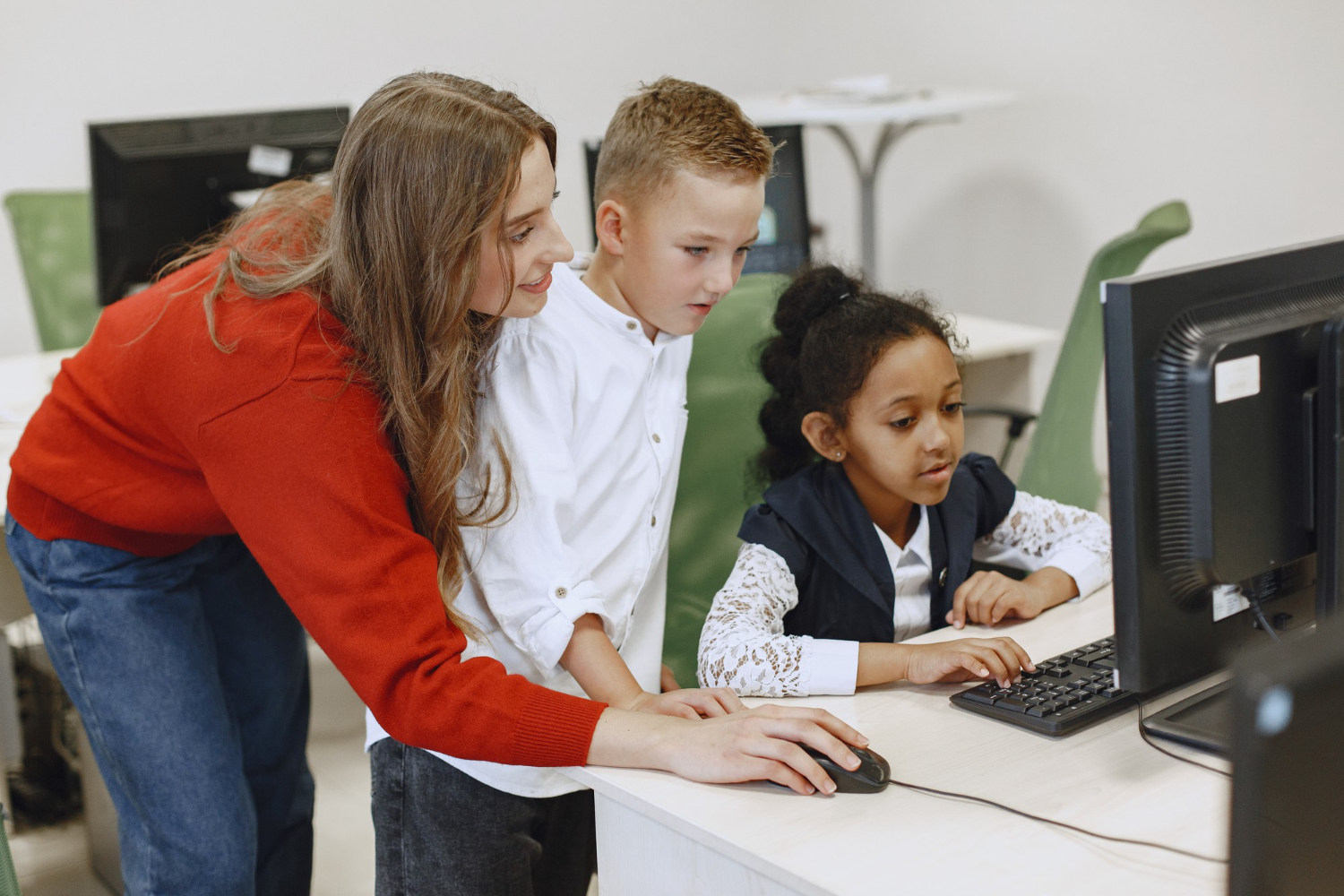The Digital Learning
As we move forward into the 21st century, it’s becoming more and more crucial to blend technology into our education systems. This integration is transforming classrooms into dynamic, interactive spaces for learning.
For substitute teachers, they need to be well-versed in using a variety of digital tools and platforms. Their role in the ever-evolving classrooms of today involves applying these technologies to make teaching methods engaging and effective.
Substitute teachers can succeed in this digital era of education by smartly integrating technology into traditional teaching models. Using resources such as interactive presentations, virtual whiteboards, and online simulations can cater to different learning needs while keeping students engaged.

Facilitating group interactions through online forums encourages critical thinking. Using Learning management systems can help maintain clear communication, manage assignments, and provide quicker feedback, enhancing productivity. Applying flipped classroom models can make in-person sessions more exciting and application-focused.
Keeping up with professional development programs allows teachers to adopt new technologies effortlessly. By carefully blending technology with traditional methods, teachers can create a flexible learning environment that prepares students for the digital age and enhances their overall educational experience.
Personalized learning
If you’re a Casual Relief Teacher (CRT), getting to know each student’s unique learning style is key. You can do this through simple tests or discussions. This will let you know about their strengths, weaknesses, and best ways to learn.

Once you have this information, you can start tailoring your lessons. This means giving extra help where necessary and finding new ways to challenge the students. By using technology like apps or online resources, you can match resources to different students’ needs.
Lastly, creating an inclusive classroom atmosphere helps you connect with students. Encouraging open chat, understanding students’ aims, and integrating their interests into lessons can make learning more relevant and interesting.
Social and emotional learning
Preparing for the Future of Education isn’t just about teaching academic subjects. It’s about nurturing the whole child, including their social and emotional growth. As a substitute teacher, you’ll find that this method offers a more complex and rewarding teaching experience.
Social and emotional learning is becoming essential in our changing, complex world. It helps students learn how to manage feelings, set and reach positive goals, empathize with others, form positive relationships, and make wise decisions. These skills are key not just for academic success, but also for becoming successful adults prepared for the future workplace.
As a substitute teacher, you bring a fresh perspective to every classroom you step into. Even though you might only be there for a short time, you have a big role in moulding the classroom dynamics and allowing the children to adapt to change in routine.

Besides teaching the required curriculum, your brief stint in each classroom presents an opportunity to bring in new ideas.
The short nature of your role is an advantage. It encourages students to express authentic feelings, knowing they have a fresh start in every session. By promoting social and emotional learning, substitute teachers create a positive, inclusive atmosphere for individual growth. Every new classroom is an opportunity for a reset, giving students an environment that nurtures both their academic knowledge and emotional intelligence.
Technological Trends in Education
What a Relief Teacher Needs to Know?

Being a substitute teacher in the constantly changing world of education can feel daunting. However, this challenge offers a chance to prove your adaptability and determination. Let’s explore how embracing technology can turn your teaching approach upside down. Interestingly, 70% of substitute teachers felt unready for the shift towards digital learning
We are now part of a time where technology reshapes teaching techniques and resources. Staying current with modern trends isn’t just nice—it’s crucial. Imagine walking into a classroom full of modern tools: interactive whiteboards, electronic textbooks, and students taking notes on tablets instead of paper.
As a substitute teacher, all this may appear intimidating. But getting a grip on these developments can enable you to provide vibrant, valuable lessons.
What are some effective strategies for teachers to upskill in technology without feeling overwhelmed?
Start Simple: Get to know the basics of tech. Learn simple applications first, then build up from there.
Set Small Goals: Set small, achievable tech goals. Celebrate each minor victory to keep morale high and avoid burnout.
Online Learning: Use websites like Coursera, edX, or Google for Education. These resources offer plenty of tech courses for teachers.
Join Learning Groups: Find groups of teachers, both in your school and online, who are also learning about tech. Share your experiences and learn from others.
Find a Mentor: Look for tech-savvy colleagues who can guide and support you during your learning journey.
Use School Resources: Your school may have resources such as professional development coaches who can provide specific guidance.
Classroom Practice: Start using tech in the classroom. Incorporate it into your lesson plans for practical experience.
Engage Students with Tech: Involve students in tech projects. Their enthusiasm can help create a positive learning environment.
Never Stop Learning: Accept that technology is always changing. Cultivate a love of continuous learning to stay updated on new educational tech trends.
Review and Update: Reflect on how your tech learning is going. Pinpoint what’s working and what’s not, and adjust your approach accordingly.
Using these strategies, you can gradually improve your tech skills. Don’t try to learn it all at once. Take your time and let your confidence in using educational technology grow gradually.
How Can Interactivity and Personalization be Increased through EdTech?
Education Technology (EdTech) helps to promote interactive and personalized learning among students. Tools like virtual reality and augmented reality can aid you in creating immersive teaching experiences. Imagine teaching geography using immersive VR experiences or conducting a science experiment through AR.
Examples on how education using augmented reality AR and virtual reality VR:
- Virtual Field Trips:
Virtual Reality (VR) is becoming a unique tool for educators, allowing students to virtually visit places like historical sites or science-based landscapes without leaving the classroom. Educational platforms, such as Google Expeditions, offer a wide range of these immersive experiences, enriching students’ learning in different subjects.
- Augmented Reality for Interactive Learning:
Augmented Reality (AR) is becoming a common tool in classrooms, making learning more fun and engaging. Educational apps like Merge Cube use AR to bring digital info into the real world. The Merge Cube is an updated version of traditional tools like flashcards. Through AR, flat pictures get transformed into interactive 3D models. This not only catches students’ attention but also helps them better understand different topics.
- Anatomy and Science Simulations:
VR and AR tools are changing the way we teach complex topics such as science and anatomy. Now, students can explore the human body through exciting 3D experiences using VR apps. Companies like zSpace – Virtual Reality for Education go even further, letting students virtually dissect specimens and take part in interactive simulations. These experiences go beyond the usual classroom lessons, offering students practical experiences that greatly boost their understanding of science subjects. encounters that significantly enhance their understanding of scientific concepts.
- Language Learning with VR:
Thanks to VR applications, students can now learn languages in a more engaging way. They can practice their language abilities in realistic settings like a make-believe restaurant or a foreign city. These experiences are rich in contextual clues that enable a deeper grasp of language subtleties and cultural insights. Tools like ImmerseMe are instrumental in this change. They offer personalized and immersive language learning experiences that significantly improve upon traditional learning methods.
- Virtual Chemistry Labs:
Virtual Reality (VR) is changing how students interact with science, especially in chemistry. VR is used to recreate chemical lab experiments, letting students handle these experiments safely in a virtual space. The benefits of this are twofold: it helps students grasp the practical aspects of chemical reactions and avoids the risks associated with dangerous materials usually used in a physical lab. Resources like Labster – Virtual Lab Simulations are critical in this process. It gives students a safe, immersive way to delve into and understand complex scientific ideas.
These examples illustrate the various ways virtual and augmented reality are changing old-school teaching methods, providing students with captivating and interactive learning experiences.
Artificial Intelligence (AI) in Teaching

Getting students to participate in their learning can be tough. But, this is where AI comes in. It gives each student a unique path to follow based on what they’re good at, what they’re not so good at, and how fast they learn. As a substitute teacher, AI can be your helpful guide, showing you how each student has been doing and how you can help them learn better.
A great example of how AI is used in teaching is the Carnegie Learning’s math tutoring platform. This AI-based system gives each student a personalised learning plan. It uses smart algorithms to see how each student is doing, where they need help, and adjusts the teaching content to suit them. It doesn’t just deliver lessons, it reacts to how the student is doing and adjusts accordingly.
Teachers get helpful, detailed information that lets them see quite clearly how a student is doing, make good decisions about teaching, and give the right kind of help when it’s needed. This tool shows just how powerful tech can be in making education more tailored to each student’s needs.
Collaborative Learning Through Digital Platforms
With the advent of Covid, there’s been an increase in schools going digital and employing remote technology for learning.
If you’re teaching in such an environment, it’s crucial to keep student engagement as a priority. However, providing praise or rewards virtually can pose a challenge for some teachers.
Here are some useful ideas and tips to engage students online:
- Let’s begin class with a quick activity to break down the barriers. Surveys, trivia questions, or a fun fact-sharing challenge can get the conversation started. Platforms like Kahoot can be a great tool for this purpose.
- Have you thought about celebrating class anniversaries, festivals, or significant milestones? A virtual party with decorations, music, or tool-related activities can help create a positive atmosphere.
- In each class, make a student the star of the day to acknowledge their exceptional conduct or skills. This can boost their self-esteem and motivate others.
- Group your students together for discussions. This can be done in breakout rooms or using separate discussion tools. This promotes team synergy and effective communication.
- Pair students together with a buddy system. This not only encourages communication but fosters friendship among them.
- Why not have our students work on online group assignments? This encourages unity and effective communication.
- Let’s make our students the teachers for a day. This not only actively engages the class but helps solidify their comprehension of the topic as well.
- Bring multimedia elements to your lessons. Videos, images, and sound clips can make learning stimulating.
- Break your lectures into bite-size pieces. Distribute them between activities and discussions or a quick comprehension check.
- Ever tried online whiteboards for brainstorming, illustrating, and instant feedback? It helps students understand the concept clearly.
- Make use of virtual manipulatives. It can be a very interactive tool that helps students understand complex topics related to math, science, or other subjects.
- Encourage the use of online forums, discussion boards, or messaging platforms for student interactions beyond the class. This gives them the freedom to learn at their own pace.
Technology and education are becoming more intertwined, especially due to the pandemic. As a substitute teacher, it’s key for you to keep up with these changes, and try new tools out.
This doesn’t just make you a fill-in, but a ‘Forward-Thinking Educator’, gearing up students for a future filled with technology.
Being a substitute teacher in the future of education brings new challenges and chances. With classrooms becoming more digital, custom-fit to every student, and focused on all-around growth, you as a Casual Relief Teacher will need to change how you teach.
Using technology, giving lessons in a new way, and promoting social and emotional learning are key parts of this change. Learn more with Airteachr to succeed in this new world of education.






